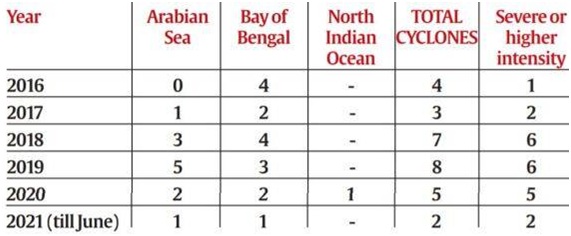Increased frequency of cyclones over the Arabian Sea
- Posted By
10Pointer
- Categories
Geography
- Published
9th Aug, 2021
-
Context
Dataset of the India Meteorological Department (IMD)’s 50-year (1970-2019) extreme weather events have shown that there increased frequency of severe cyclonic storms.

About the rise in cyclones in the Arabian Sea
- An analysis of past data of cyclones over the North Indian Ocean (the Bay of Bengal and the Arabian Sea) during the period 1891–2020 indicates that the frequency of extremely severe cyclonic storms has been increased in recent few years over the Arabian Sea since 1990, and remained the same over the Bay of Bengal.
- These events had significant impacts over various regions of the Indian subcontinent leading to
- loss of lives and property
- adversely affecting the livelihood of the vulnerable community
Reasons behind the increase in cyclones in the Arabian Sea
- The low-pressure systems of cyclones are formed when warm, moist air rises from the sea surface.
- The recent frequency of cyclones is a clear sign of temperatures rising in the Arabian Sea.
- The rapid warming of the Arabian Sea is leading to not only more cyclones but also more extreme rain events.
- Due to these warm ocean conditions, the cyclone intensifies from a weak cyclone to an extremely severe cyclone rapidly.
- The seawater till 50 metres has been very warm which supplies ample energy to enable the intensification of Cyclone Tauktae.
- The more heat released by the condensation of water vapour results in the steeper drop in the pressure which undergoes multiple stages of intensification to form cyclones.
Why more Cyclones are formed over the Bay of Bengal?
The Bay witnesses cyclones both pre-monsoon and post-monsoon due to a number of reasons;
- Higher sea surface temperature
- weak vertical mixing in BOB
- huge perennial freshwater influx from Himalayan Rivers
- basin rainfall and sluggish wind
|
